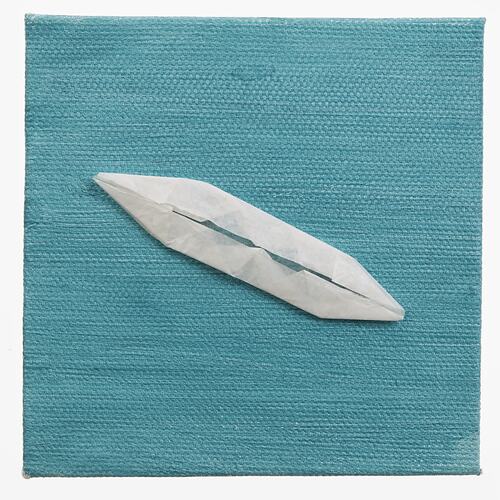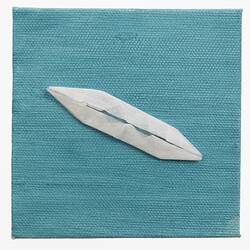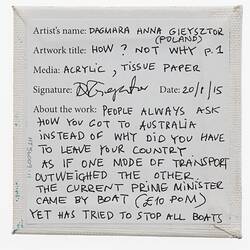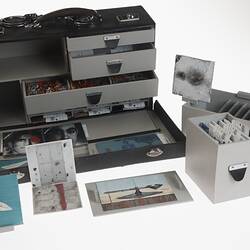Summary
Artwork entitled 'How? Not - Why P.1' created in 2015 by Melbourne-based Polish refugee,Dagmara Gieysztor. It is part of 'Attache Case', a collective artwork co-ordinated by Peter Burke in 2015. Dagmara also created another artwork in this collection: 'How? Not - Why P.2' (HT56009.12).
Artist statement provided by Dagmara in 2021:
'Dagmara has been a multidisciplinary artist for 25 years which led her to becoming a visual dramaturg, practising in theatre and contemporary dance in Australia and internationally. She runs an artist residency in her hometown of Lodz, Poland. She is lecturer at the Victorian College of the Arts (University of Melbourne) in various subjects and is starting a mentorship program for artists of diverse backgrounds.'
This collective artwork, entitled 'Attache Case' (HT56009), was created by Melbourne artist, curator and lecturer Peter Burke in 2015 as part of an international touring art installation, 'Low-Cost Diplomatic Bag', auspiced by the Spanish Embassy, and curated by Nilo Casares and ArtEx Madrid. It travelled to the Spanish Embassies in five countries, including Australia, in 2015-2016 (one venue included Immigration Museum, Melbourne). 'Attache Case' is comprised of a re-purposed doctor's medical case which opens to reveal small drawers containing 41 individuals' miniature artworks representing 21 refugees from Afghanistan, Vietnam, Poland, Colombia, Sri Lanka, Iran, Egypt and Iraq.
The artworks inside the case are acrylic and oil paintings and collage works on canvas board and copper. Many artworks have handwritten descriptions on paper by the artists on the reverse. The collection also includes a video about the project by César Espada produced in 2015.
Physical Description
Acrylic & tissue paper on canvas board. Folded paper boat on a tourquoise blue background.
Significance
'Attache Case' is a collective artwork created in 2015 in response to an invitation by artist, Peter Burke, to a number of asylum seekers and refugees in Melbourne to express their experience visually. The refugees and asylum seekers (some in detention at the time of the project) who produced the artworks came from diverse countries including Afghanistan, Vietnam, Poland, Hungary, Colombia, Sri Lanka, Iran, Egypt and Iraq. They explore diverse themes relating to detainment, immigration, border security policies, bureaucracy, and mental health.
The artists convey thoughts and feelings about freedom, opprtunities, life in Australia, resettlement, optimism, despair, grief, hope, fear and anger and the consequences of living in limbo. These refugee and asylum seeker's voices, concerns, and personal perspectives are not often publicly expressed and more often manipulated by media and politics or silenced in their community.
This complex artwork contains a diversity of cultures, genders, experiences, artistic styles, and responses. The oil and acrylic paintings are objects rich with symbolic meaning - both as a part of a luggage item reminiscent of the migrant experience, as well as a traveller's borderless container (representing migration, diplomacy, policy and bureaucracy) of voices that speak to the issues that are at the heart of the asylum seeker situation and debate.
More Information
-
Collecting Areas
-
Artist
-
Creator
-
Inscriptions
Reverse side [handwritten]: 'DAGMARA ANNA GIEYSZTOR/(POLAND)/HOW? NOT WHY P.1/ACRYLIC, TISSUE PAPER/[signature]/20/1/15/ PEOPLE ALWAYS ASK/ HOW WE GOT TO AUSTRALIA/ INSTEAD OF WHY DID YOU HAVE/ TO LEAVE YOUR COUNTRY./AS IF ONE MODE OF TRANSPORT/OUTWEIGHTED THE OTHER./THE CURRENT PRIME MINISTER/ CAME BY BOAT (£10 Pom)/ YET HAS TRIED TO STOP ALL BOATS'
-
Classification
Cultural identity, Ethnicity - creative practice, Mixed media
-
Category
-
Discipline
-
Type of item
-
Overall Dimensions
100 mm (Length), 100 mm (Width)
-
Keywords
Refugees, Artists, Artistic Practices, Artworks, Immigration Debates, Immigration Selection, Immigration, Luggage, Detention Centres, Activism, Politics, Ethnic Groups, Polish Communities, Polish Immigration



